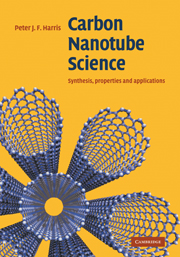Book contents
- Frontmatter
- Contents
- Preface
- 1 Introduction
- 2 Synthesis I: arc- and laser-vaporization, and heat treatment methods
- 3 Synthesis II: catalytic chemical vapour deposition and related methods
- 4 Purification and processing
- 5 Structure
- 6 Physical properties I: electronic
- 7 Physical properties II: mechanical, optical and thermal
- 8 Chemistry and biology of nanotubes
- 9 Carbon nanotube composites
- 10 Filled and heterogeneous nanotubes
- 11 Probes and sensors
- 12 Conclusions
- Name Index
- Subject Index
2 - Synthesis I: arc- and laser-vaporization, and heat treatment methods
Published online by Cambridge University Press: 20 May 2010
- Frontmatter
- Contents
- Preface
- 1 Introduction
- 2 Synthesis I: arc- and laser-vaporization, and heat treatment methods
- 3 Synthesis II: catalytic chemical vapour deposition and related methods
- 4 Purification and processing
- 5 Structure
- 6 Physical properties I: electronic
- 7 Physical properties II: mechanical, optical and thermal
- 8 Chemistry and biology of nanotubes
- 9 Carbon nanotube composites
- 10 Filled and heterogeneous nanotubes
- 11 Probes and sensors
- 12 Conclusions
- Name Index
- Subject Index
Summary
As we saw in the last chapter, the excitement surrounding carbon nanotubes was originally sparked by Iijima's production of highly perfect multiwalled tubes using arc-evaporation in 1991. Although the catalytic production of carbon tubules had been known for decades, the structures discovered by Iijima displayed a degree of perfection much greater than those seen in catalytic tubes. The first synthesis of single-walled nanotubes in 1993 also involved arc-evaporation, this time with metal-impregnated electrodes. Arc-evaporation remains an important method of nanotube synthesis, and will be discussed in detail in this chapter. The chapter begins with a description of the practical aspects of the arc synthesis of multiwalled nanotubes. A summary of the various models that have been put forward for the growth of multiwalled tubes in the arc is then given. This is followed by a discussion of the production of multiwalled nanotubes by high-temperature heat treatment of disordered carbon. The synthesis of single-walled carbon nanotubes by arc-evaporation and by laser-vaporization is then covered, and the possible mechanisms of nanotube formation in these processes summarized. Finally, the arc synthesis of double-walled nanotubes is described.
Production of multiwalled nanotubes by arc-evaporation
Early work
The original method used by Iijima to prepare nanotubes (2.1) differed slightly from the Krätschmer–Huffman technique for C60 production in that the graphite electrodes were held a short distance apart during arcing, rather than being kept in contact. Under these conditions, some of the carbon which evaporated from the anode recondensed as a hard cylindrical deposit on the cathodic rod. It was the central part of this deposit that Iijima found to contain both nanotubes and nanoparticles.
- Type
- Chapter
- Information
- Carbon Nanotube ScienceSynthesis, Properties and Applications, pp. 14 - 42Publisher: Cambridge University PressPrint publication year: 2009
- 1
- Cited by

